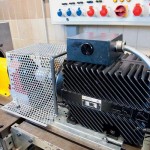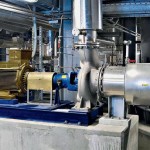Reluctance synchronous motors are energy savers. The drives, which are currently undergoing field testing on pumps of various sizes, have at least 15 % less power dissipation than that prescribed for efficiency class IE3. In other words, they already satisfy the future standard efficiency level IE4. Specific to a unit’s load profile and model size, up to 9 % electricity can be saved by replacing a class-IE2 asynchronous motor with a reluctance synchronous motor.
The author: Horst Stegmüller Freelance journalist
The Italian KSB subsidiary Itaco/Reel s.r.l. designs and manufactures highly efficient electric motors for industrial applications. Itaco/Reel drives, whose electromechanical working principle places them in the reluctance synchronous motor category, are real energy savers. “Our motors have at least 15 % less power dissipation than that prescribed for efficiency class IE3 (IEC 60034–30)”, explains Dr. Jochen Schaab, who is in charge of drive development in KSB’s Automation & Drives Business Unit. “In other words, they already satisfy the future standard efficiency level IE4. Compared with an asynchronous motor”, Dr. Schaab continues, “an additional 3 to 7 % saving can be achieved for the overall system (= motor plus frequency inverter), depending on the particular application and motor size. Small units can even conserve an additional 5 to 9 % compared with an IE2 machine.”
The legal situation is also tightening up for asynchronous motors, like those presently in use on nearly all chemical and process engineering pumps. Efficiency level IE2 is specified since June 2011, while efficiency level IE3 (or IE2 in combination with speed control) will be required for ratings between 7.5 and 375 kW as of January 2015. Beginning in January 2017, class IE3 will be binding for all asynchronous motors. How asynchronous motors can be made to satisfy the envisaged efficiency level IE4 – and what it will cost – is not yet clear. However, reluctance synchronous motors have already been identified as a universally suitable alternative.
The technical principle
Like asynchronous motors, the motors built by KSB’s subsidiary have a stator winding. Their four-pole rotor consists only of a laminated core without a cage. The rotor laminations are specially shaped to guide the lines of flux, i.e. they channel the magnetic field within the rotor in the preferred direction to achieve the requisite alignment. When the field within the stator rotates at a certain speed, the reluctance principle makes the rotor follow the rotary field in synchrony, with no slip. Whereas in an asynchronous motor the torque is generated by the Lorentz force acting on the current-carrying rotor cage, the reluctance motor has no such cage, so there is no flow of electricity within the rotor either. Hence, the losses inherent to asynchronous motors are avoided.
The aforementioned savings relate to the rated operating point, because that is the point for which the standard prescribes efficiency testing. In industrial reality, however, many motors tend to operate in their part load range instead of at their rated operating point. Against this background, the efficiency of reluctance synchronous motors emerges as even more superior. As the diagram shows, the efficiency of asynchronous motors is significantly lower in the part load range, typically a good 10% below optimum. Reluctance synchronous motors, on the other hand, maintain a more or less constant, high level of efficiency across their entire load and speed range between 25 and 100 %. Under actual field conditions, then, their efficiency – compared with that of asynchronous motors – is even better than one would assume on the basis of the rated operating points alone.
Lower overall costs
A reluctance synchronous motor requires a frequency inverter for starting and for compensating its reactive current requirement. Nevertheless, its overall lifecycle cost is considerably lower than that of an asynchronous motor. According to ZVEI, power consumption accounts for more than 90 % of all costs attributable to a given electric motor. As such, the initial cost of investment plays a minor role in comparison to the overall cost of operation. Variable speed operation of a centrifugal pump, for example, can consume as much as 60 % less energy, depending on the pump’s load profile. Specific to a unit’s load profile and model size, up to 9 % electricity can be saved by replacing a class IE2 asynchronous motor with a reluctance synchronous motor.
Since KSB motors dissipate less energy, they also generate less waste heat. Consequently, the design engineers can downsize the fans. That is also good for efficiency. In fact, in one pilot project, the fan was dispensed with entirely for a number of applications with motors of various sizes, hence achieving further energy savings.
For a reluctance synchronous motor to run well, the exact position of its rotor must be known, because the magnetic field has to be continually adjusted to its momentary position. In the past, motor manufacturers have always used so-called rotor position indicators for this purpose. Such sensors, however, are not only expensive; they also increase the risk of malfunction. Reel engineers, though, have found out how to monitor the position of the rotor without the need for sensors, which has eliminated one of the drawbacks of conventional reluctance synchronous motors.
The fact that the motors’ working principle requires no cage for the rotor has positive effects on the manufacturing costs. This advantage will become even greater in the future when asynchronous motors are expected to satisfy efficiency level IE3, because motor manufacturers tend to equip their rotors with copper cages for this purpose. These are considerably more expensive in terms of both material and labour than today’s still customary, loss-prone aluminium cages. More efficient asynchronous motors will also need larger winding assemblies with correspondingly higher expenditure for copper and attendant costs. By contrast, the cost of raw materials for reluctance synchronous motors is much lower. Above all, no rare earths or other critical raw materials like those used in the production of permanent-magnet synchronous motors are needed for their manufacture.
Good for many industrial applications
The German industry is already field testing the reluctance synchronous motors on pumps of various sizes. KSB’s subsidiary is in a position to turn out motors with ratings up to 110 kW. Their working principle lets them maintain a given synchronous speed with a deviation of less than 0.01 %. Unlike reluctance stepper motors, they simultaneously maintain a torque ripple of only 1 or 2 % and are therefore extremely quiet in operation. “Thanks to their high energy saving potential and excellent electromechanical properties”, Dr. Schaab observes, “these motors are well suited for nearly any industrial application, including for example materials handling and automation or industrial machines as well as generally wherever variable speed drives are essential. All it takes to make them ready for applications where a KSB PumpDrive is already employed is an update for the frequency inverter software.”
Online-Info: www.cpp-net.com/2211418
Share:











